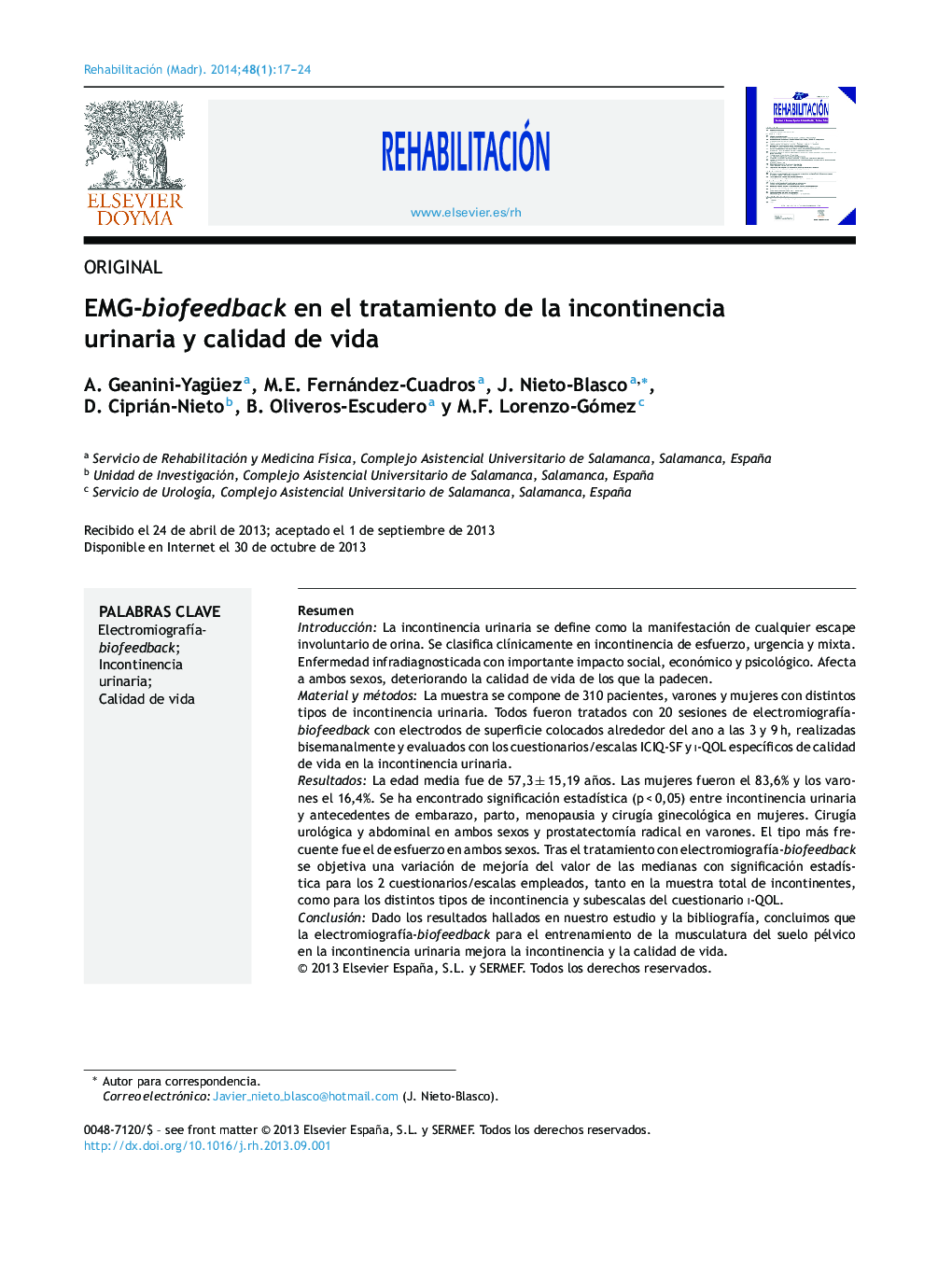| Article ID | Journal | Published Year | Pages | File Type |
|---|---|---|---|---|
| 4084854 | Rehabilitación | 2014 | 8 Pages |
ResumenIntroducciónLa incontinencia urinaria se define como la manifestación de cualquier escape involuntario de orina. Se clasifica clínicamente en incontinencia de esfuerzo, urgencia y mixta. Enfermedad infradiagnosticada con importante impacto social, económico y psicológico. Afecta a ambos sexos, deteriorando la calidad de vida de los que la padecen.Material y métodosLa muestra se compone de 310 pacientes, varones y mujeres con distintos tipos de incontinencia urinaria. Todos fueron tratados con 20 sesiones de electromiografía-biofeedback con electrodos de superficie colocados alrededor del ano a las 3 y 9 h, realizadas bisemanalmente y evaluados con los cuestionarios/escalas ICIQ-SF y I-QOL específicos de calidad de vida en la incontinencia urinaria.ResultadosLa edad media fue de 57,3 ± 15,19 años. Las mujeres fueron el 83,6% y los varones el 16,4%. Se ha encontrado significación estadística (p < 0,05) entre incontinencia urinaria y antecedentes de embarazo, parto, menopausia y cirugía ginecológica en mujeres. Cirugía urológica y abdominal en ambos sexos y prostatectomía radical en varones. El tipo más frecuente fue el de esfuerzo en ambos sexos. Tras el tratamiento con electromiografía-biofeedback se objetiva una variación de mejoría del valor de las medianas con significación estadística para los 2 cuestionarios/escalas empleados, tanto en la muestra total de incontinentes, como para los distintos tipos de incontinencia y subescalas del cuestionario I-QOL.ConclusiónDado los resultados hallados en nuestro estudio y la bibliografía, concluimos que la electromiografía-biofeedback para el entrenamiento de la musculatura del suelo pélvico en la incontinencia urinaria mejora la incontinencia y la calidad de vida.
IntroductionUrinary incontinence (UI) is defined as any involuntary loss of urine. Clinically, it is classified into three categories: stress, urgency and mixed incontinence. The diagnosis of UI is underdiagnosed, this having an economic, social and psychological impact. It affects both male and female, with deterioration in their quality of life (QOL).Material and methodsThe sample was made up of 310 patients, male and female, with different types of UI. They were all treated with 20 sessions of electromiography-biofeedback, twice a week. Superficial electrodes were used around the anus, at 3 and 9 o’clock hours, and self administered ICIQ-SF and I-QOL questionnaires/scales were used.ResultsMean age was 57.3±15.19 years. There were 83.6% female and 16.4% male. A statistically significant (P<.05) difference was found between UI and background of pregnancy, delivery, menopause and gynecological surgery in women; abdominal and urogynecological surgery in both sexes; and radical prostatectomy in males. The most frequent IU type was effort in both sexes. After electromiography-biofeedback treatment, we have found a statistically significant improvement (P<.05) in the mean values for both of the questionnaire/scales used, in the UI sample of incontinent patients and for the different UI types, as well as in the different I-QOL subscales.ConclusionAfter analyzing our data and the literature reviewed, we have concluded that electromyography-biofeedback is effective as a training technique of the pelvic floor muscles in urinary incontinence and in improving the quality of life of such patients.
